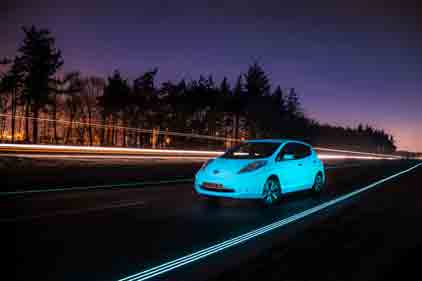Glow-in-the-Dark Nissan LEAF Drives on Glowing Highway in the Netherlands

OSS, the Netherlands – Nissan has blazed a trail by driving its unique glow-in-the-dark zero-emission LEAF along the world's first glow-in-the-dark motorway in Oss, the Netherlands.
Nissan recently became the first modern passenger car manufacturer to apply glow-in-the-dark car paint to a car to showcase how many customers of the world's best-selling electric vehicle are powering their car from solar energy generated at home.
The company has now gone one step further by driving the all-electric Nissan LEAF on the Smart Highway in the Netherlands – the first time a phosphorescent car has been driven on the famous stretch of road. The location of the world's only luminescent highway was fitting, as Nissan has announced an increase in electric vehicle sales of 313 percent in the Netherlands last year.
The innovative Smart Highway project was conceived by designer Daan Roosegaarde. His idea: help guide drivers in the dark while saving energy that might otherwise be used in street lighting.
A 600-meter stretch of the N329 highway – a major transport link that runs through the city of Oss – has been upgraded with glowing lines that absorb light during the day and glow for eight hours at night. Here, the landscape becomes an experience of light and information, increasing visibility and safety.
"The glowing lines on the Smart Highway replace standard street lighting to reduce electrical energy consumption," said Roosegaarde. "To have the world's first glow-in-the-dark car on our road is a privilege, and it mirrors goals that we want to achieve with our Smart Highway."
The road's photo-luminescent strips complement the Nissan LEAF's innovative finish. The spray-applied coating absorbs UV energy and other visible radiation during daylight hours and glows for between eight and 10 hours when the sun goes down.
While glowing car paint is already available, as are glow-in-the-dark car wraps, the bespoke, ultraviolet-energized paint created especially for Nissan is unique thanks to its secret formula. It contains a solid, odorless rare earth metal called strontium aluminate.
Looking for a reprint of this article?
From high-res PDFs to custom plaques, order your copy today!





